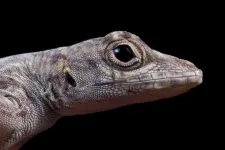(Press-News.org) Graphics
It's well-known that birds and other animals rely on Earth's magnetic field for long-distance navigation during seasonal migrations.
But how do periodic disruptions of the planet's magnetic field, caused by solar flares and other energetic outbursts, affect the reliability of those biological navigation systems?
University of Michigan researchers and their colleagues used massive, long-term datasets from networks of U.S. Doppler weather radar stations and ground-based magnetometers—devices that measure the intensity of local magnetic fields—to test for a possible link between geomagnetic disturbances and disruptions to nocturnal bird migration.
They found a 9%-17% reduction in the number of migrating birds, in both spring and fall, during severe space weather events. And the birds that chose to migrate during such events seemed to experience more difficulty navigating, especially under overcast conditions in autumn.
The new findings, scheduled for online publication the week of Oct. 9 in Proceedings of the National Academy of Sciences, provide correlational evidence for previously unknown relationships between nocturnal bird migration dynamics and geomagnetic disturbances, according to the researchers.
"Our findings highlight how animal decisions are dependent on environmental conditions—including those that we as humans cannot perceive, such as geomagnetic disturbances—and that these behaviors influence population-level patterns of animal movement," said study lead author Eric Gulson-Castillo, a doctoral student in the U-M Department of Ecology and Evolutionary Biology.
Earth's magnetic field is regularly impacted by solar outbursts that can trigger colorful auroras and that sometimes disrupt satellite communications, human navigation systems and power grids.
But little is known about how those disturbances affect animals that depend on Earth's magnetic field for migratory orientation and navigation. Previous experimental studies over several decades provide strong evidence that birds, sea turtles and other organisms key into small changes in magnetic inclination, intensity and declination when making orientation decisions and developing navigational maps.
One recent study examined millions of bird banding records and found that geomagnetic disturbances were associated with increased incidence of migratory bird "vagrancy," that is, birds becoming lost during migration.
But most previous studies were narrowly focused in geographic extent, duration and the number of species examined. The newly published study, in contrast, uses a 23-year dataset of bird migration across the U.S. Great Plains to provide new insights at population and landscape levels.
The researchers used images collected at 37 NEXRAD radar stations in the central flyway of the U.S. Great Plains, a major migratory corridor. The flyway spans more than 1,000 miles in the U.S., from Texas to North Dakota.
The research team selected this relatively flat region to minimize influences from mountainous topography or oceanic and Great Lakes coastlines. Their final datasets included 1.7 million radar scans from the fall and 1.4 million from the spring.
The community of nocturnally migrating birds in this region is primarily composed of a diverse set of perching birds (Passeriformes, 73% of species) such as thrushes and warblers; shorebirds (Charadriiformes, 12%) such as sandpipers and plovers; and waterfowl (Anseriformes, 9%) such as ducks, geese and swans.
The NEXRAD radar scans detect groups of hundreds to thousands of migrating birds. Migration intensity—meaning the number of birds in each cluster—can be estimated and direction of flight can be measured.
Concurrent geomagnetic measurements were accessed through superMAG, a worldwide collection of geomagnetic ground stations. Data were collected from magnetometer stations near weather radar sites.
The researchers matched data from each radar station with a customized, spatiotemporally explicit index of geomagnetic disturbance that represents the maximum hourly change from background magnetic conditions.
U-M space scientist Daniel Welling and former University of Texas at Arlington undergraduate Michelle Bui compiled the space weather data and designed the geomagnetic disturbance index. Welling and Bui are co-authors of the new study.
"The biggest challenge was trying to distill such a large dataset—years and years of ground magnetic field observations—into a geomagnetic disturbance index for each radar site," said Welling, assistant professor in the Department of Climate and Space Sciences and Engineering at the U-M College of Engineering. "There was a lot of heavy lifting in terms of assessing data quality and validating our final data product to ensure that it was appropriate for this study."
The data trove was fed into two complementary statistical models to measure the putative effects of magnetic disturbances on bird migration. The models controlled for the known effects of weather, temporal variables such as time of night and geographic variables such as longitude and latitude.
"We found broad support that migration intensity decreases under high geomagnetic disturbance," said study senior author Ben Winger, assistant professor in the U-M Department of Ecology and Evolutionary Biology and a curator of birds at the U-M Museum of Zoology.
"Our results provide ecological context for decades of research on the mechanisms of animal magnetoreception by demonstrating community-wide impacts of space weather on migration dynamics."
The researchers also found that migrating birds appear to drift with the wind more frequently during geomagnetic disturbances in the fall, instead of expending great effort to battle crosswinds.
"Effort flying" against the wind was reduced by 25% under cloudy skies during strong solar storms in the fall, suggesting that a combination of obscured celestial cues and magnetic disruption may hinder navigation.
"Our results suggest that fewer birds migrate during strong geomagnetic disturbances and that migrating birds may experience more difficulty navigating, especially under overcast conditions in autumn," said Gulson-Castillo, who conducted the study as part of his doctoral dissertation. "As a result, they may spend less effort actively navigating in flight and consequently fly in greater alignment with the wind."
In addition to Gulson-Castillo, Winger, Welling and Bui, the authors of the PNAS paper are Benjamin Van Doren of Cornell University, Kyle Horton of Colorado State University, Jing Li of the U-M Department of Statistics and Department of Biostatistics, Mark Moldwin of U-M's Department of Climate and Space Sciences and Engineering, and Kerby Shedden of the U-M Department of Statistics.
Winger and Moldwin were supported by a University of Michigan MCubed grant. Gulson-Castillo was supported by a National Science Foundation Graduate Research Fellowship Grant and a U-M Rackham Merit Fellowship. Van Doren was supported by a Cornell Presidential Postdoctoral Fellowship. Moldwin was also supported by an NSF grant.
"Space weather disrupts nocturnal bird migration," DOI 10.1073/pnas.2306317120
END
Space weather disrupts nocturnal bird migration, study finds
2023-10-09
ELSE PRESS RELEASES FROM THIS DATE:
Long-term lizard study challenges the rules of evolutionary biology
2023-10-09
Charles Darwin said that evolution was constantly happening, causing animals to adapt for survival. But many of his contemporaries disagreed. If evolution is always causing things to change, they asked, then how is it that two fossils from the same species, found in the same location, can look identical despite being 50 million years apart in age?
Everything changed in the past 40 years, when an explosion of evolutionary studies proved that evolution can and does occur rapidly — even from one generation to the next. Evolutionary biologists were thrilled, but the findings reinforced the same paradox: If evolution can happen so fast, then why do most species on Earth continue to ...
No lizard is an island
2023-10-09
Many species experience little to no change over long periods of time. Biologists often fall back on the same explanation for why this is true: that natural selection favors individuals with more moderate characteristics. Individuals with more extreme features — longer limbs, for example — have a disadvantage, while more moderate or average individuals are more likely to survive and reproduce, passing on their common features.
But new research from Washington University in St. Louis and the Georgia ...
Nature is inventive - the same substance is produced differently by plants
2023-10-09
Maize plants form special compounds derived from indole, the so-called benzoxazinoids. They are considered ecologically important because they act against a wide range of herbivores and reduce their feeding. Benzoxazinoids also exhibit antimicrobial properties and are thought to be involved in mediating plant-plant interactions. Their biosynthesis in maize has been known since the 1990s. Meanwhile, their biosynthetic pathway has been described in several grasses, but benzoxazinoids have also been found in other plant species. Their distribution is peculiar: While specialized metabolites often occur in specific evolutionary related plant species, benzoxazinoids ...
AI language models could help diagnose schizophrenia
2023-10-09
Scientists at the UCL Institute for Neurology have developed new tools, based on AI language models, that can characterise subtle signatures in the speech of patients diagnosed with schizophrenia.
The research, published in PNAS, aims to understand how the automated analysis of language could help doctors and scientists diagnose and assess psychiatric conditions.
Currently, psychiatric diagnosis is based almost entirely on talking with patients and those close to them, with only a minimal role for tests such as blood tests and brain scans.
However, ...
Ancient Maya reservoirs offer lessons for today’s water crises
2023-10-09
CHAMPAIGN, Ill. — According to a new paper, ancient Maya reservoirs, which used aquatic plants to filter and clean the water, “can serve as archetypes for natural, sustainable water systems to address future water needs.”
The Maya built and maintained reservoirs that were in use for more than 1,000 years, wrote University of Illinois Urbana-Champaign anthropology professor Lisa Lucero in a perspective in the Proceedings of the National Academy of Sciences. These reservoirs provided potable water for thousands to tens of thousands of people in cities during the annual, five-month dry season and in periods of prolonged ...
Evidence from the remains of 1918 flu pandemic victims contradicts long-held belief that healthy young adults were particularly vulnerable
2023-10-09
Hamilton, ON, Oct. 9, 2023 – New analysis of the remains of victims of the 1918 influenza pandemic, which killed an estimated 50 million people worldwide, contradicts the widespread belief the flu disproportionately impacted healthy young adults.
Because so many people fell ill so quickly, physicians at the time believed the healthy were as likely to die from the flu as those who had already been sick or frail. Despite numerous historical accounts, though, it turns out there is no concrete scientific evidence to support that belief.
Researchers at McMaster University and the University of Colorado Boulder ...
Could a specialized diet alleviate long COVID?
2023-10-09
LOS ANGELES — Approximately 7% of Americans have had long COVID, a range of ongoing health problems experienced after infection and recovery from COVID-19. Symptoms can include fatigue, brain fog, headaches, chest pain, heart palpitations and more.
To date, there is no proven treatment for the syndrome, and the mechanisms that cause it are not fully understood.
Now, a new clinical trial from Keck Medicine of USC is investigating if a diet designed to lower inflammation may play a role in easing this often debilitating condition.
The premise of ...
Miriam Merad, M.D., Ph.D., elected to the National Academy of Medicine for seminal work in immunology and cell biology
2023-10-09
Miriam Merad, M.D., Ph.D., an esteemed immunologist at the Icahn School of Medicine at Mount Sinai, has been elected to the National Academy of Medicine (NAM) in recognition of her pioneering contributions to the fields of immunology and cell biology.
Dr. Merad was elected for her transformational discoveries, establishing for the first time that tissue-resident macrophages have distinct origins, maintain their lineage separately from adult hematopoiesis, and possess unique functions that enhance tissue health, repair, infection defense, and impact tumor outcomes.
She is the Mount Sinai Professor ...
New drug offers relief for treatment-resistant epilepsy patients
2023-10-09
In cases where standard therapies fail, a medication called XEN1101 reduces seizure frequency by more than 50% in some patients and sometimes eliminates them altogether, a new study shows. Unlike several treatments that must be started at low doses and slowly ramped up, the new drug can safety be taken at its most effective dose from the start, the authors say.
Focal seizures, the most common type seen in epilepsy, occur when nerve cells in a particular brain region send out a sudden, excessive burst of electrical signals. Along with seizures, this uncontrolled activity can lead to abnormal behavior, periods of lost awareness, and mood changes. ...
Capturing immunotherapy response in a blood drop
2023-10-09
*EMBARGOED UNTIL 11 A.M. MONDAY, OCT. 9*
Liquid biopsies are blood tests that can serially measure circulating tumor DNA (cell-free DNA that is shed into the bloodstream by dying cancer cells). When used in patients with advanced non-small cell lung cancer undergoing immunotherapy, they may identify patients who could benefit from treatment with additional drugs, according to a phase 2 clinical trial in the U.S. and Canada. The trial is led by investigators at the Johns Hopkins Kimmel Cancer Center and its Bloomberg~Kimmel ...






